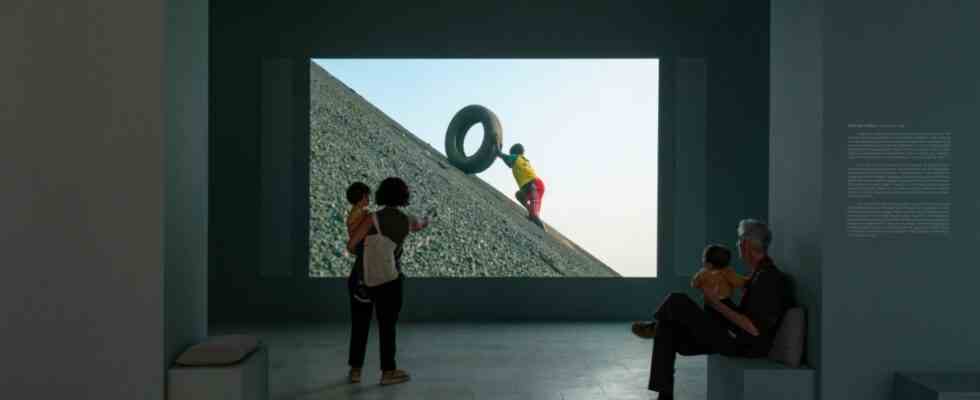They are as indispensable to every Venice Biennale as the overcrowded water buses and the oceans at Aperol, which are drunk down here after looking at the art: the assurances that, firstly, the national self-portrayal in the pavilions of the participating countries is basically a thing of the past. Secondly, the idea that art can be judged by a professional judge, as if it were a floor exercise competition.
Equally indispensable are the particularly long queues in front of the national pavilions and the general speculation about who the jury will award with the Golden Lion. The jury remains silent as a matter of principle until the oracles have left exhausted after the days of the preview. Only then does she announce. And then everything that supposedly didn’t really matter before becomes very important again.
The American artist Simone Leigh with her Golden Lion.
(Photo: Felix Hörhager/dpa)
Over the weekend, the jury announced: The Golden Lion for what it considers the best national pavilion goes to Great Britain and Sonia Boyce, the Golden Lion for the best participating artist in the international exhibition of the Biennale to the American Simone Leigh. One for life’s work goes to the German Katharina Fritsch and to Cecilia Vicuña from Chile. There was a young lion for Ali Cherri from Lebanon.
The Russian house stays completely closed out of shame about itself
The latter shows one of the few films at this biennial, which used to be dominated by video installations. Long, poetic images deal with the kneading of clay bricks when building a dam in Sudan and the mythical potential of this archaic material. Fritsch is showing the hyper-realistic sculpture of an at least life-size elephant, a work from the 1980s which, in the context of the exhibition in the Giardini, is intended to refer to an elephant that was said to have been at home here long before the Biennale was founded, as well as to the matriarchy that exists among these animals reigns. In short, Vicuña’s images position pre-Columbian imagery and myths in a feminist way. These awards clearly set the focus of the content Biennale curator Cecilia Alemani away.
And the lion for Leigh? Leigh has also filled the USA pavilion with her large bronze figures of black female figures satirizing Europe’s heroic monument culture and transformed it externally into an African straw hut. However, the award in the narrower sense is for a sculpture that opens the Biennale exhibition in the Arsenale and that was first seen on the New York Highline a few years ago. Their art program was also curated by Cecilia Alemani at the time. Suddenly, high above 10th Avenue, there towered an archaic black female figure with a hoop skirt as a base, which was supposed to be reminiscent of an African bast hut. (What is less communicated in Venice, but plays a role in the USA: representation by more abstract monuments in public space are often rejected by the communities, there is evidently an interest in figurations that respond, so to speak, in the appropriate key to the heroic bronze statues of white colonizers.) Sonia Boyce, on the other hand, is British with Caribbean roots. Her pavilion aims to celebrate the power of female voices; this is done with an elaborate sound installation and with posters that pay homage to the singer Tanita Tikaram.
Honored for the best country pavilion: the British artist Sonia Boyce.
(Photo: Felix Hörhager/dpa)
Reports that “the Biennale” primarily wanted to honor “black female artists” raises questions of origin, skin color and gender at first glance perhaps a bit harshly about the quality of their artistic contributions. Especially since there is no lack of high-class art at this Biennale, especially by black women of all possible origins and nationalities. The fact that Great Britain and the USA, of all things, are the epitome of what was once considered an imperialist nation triumphing in this way is a punchline that only the miniature world community of Venice can pull off so nicely. France’s Pavilion has at least received an “Honourable Mention” for an installation and performance dealing with Algerian heritage in France. And the Russian pavilion remains completely closed out of shame about the topicality of its own imperialism. Sometimes, but really only sometimes, a single security guard takes care that he doesn’t get disfigured.
“The Germans”, to stay in the somewhat essentialist tone of this edition of the Biennale in particular, the Germans have to live with the fact that the somewhat unfair joke has been circulating in the streets of Venice for years, according to which at the German pavilion only one Ask the question: Is he already dealing with himself and his story again – or will he win the Golden Lion? It’s been a long time since we managed to do both at once. But over the last few years there has also been a recommendable one Book from the Institute for Foreign Relations at Schirmer Mosel.
Despite this, it remains a blessing overall that so many states continue to afford a pavilion here. That makes Venice the only real world art exhibition. Everywhere else there is one curator, one curatorial team, one view of the world and things, but here there are many. So finally, a recommendation that has less to do with black women and more with black girls (and boys, as well as white, Asian, Latin American): Francis Alÿs is showing a selection of his films of playing children in the Belgian pavilion. You can hardly tell anything smarter, more touching, even more political about the world and the times in which they live. And for those who stayed at home Alÿs also shows them online.

